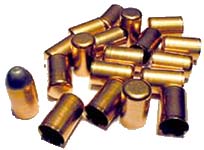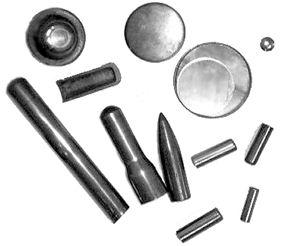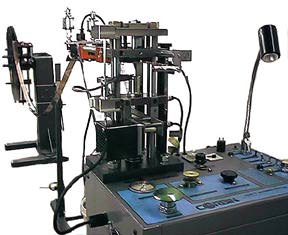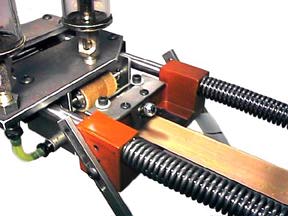| Home | Presses | Intro | Site Map | P.R. | Chemicals | Answers |

|
| Prices | Specials | How To | Bullets | B.Makers | Books | Classified | |
| Topics | Kits | Terms | Training | Software | Products | Contact us |
| Home | Presses | Intro | Site Map | P.R. | Chemicals | Answers |

|
| Prices | Specials | How To | Bullets | B.Makers | Books | Classified | |
| Topics | Kits | Terms | Training | Software | Products | Contact us |
|
|
|||||||||||||||
| |||||||||||||||
|
Jackets are the "skin" of a bullet, starting as empty cylinders which are then filled with compressed core material, expanded to exact diameter, and shaped into the bullet desired. Jackets are usually made 0.003 to 0.006 inches SMALLER than the actual bullet diameter, to allow for expansion as the core is seated, which results in a snug grip between the "stretched" jacket and the inserted core (usually made of lead, but can be any compressible material or powdered metal). Cores generally need to be able to flow under pressure in order to expand the jacket. Jackets are not "put on" the core; instead the jacket is blown up like a balloon by the tons of force applied to the malleable core during core seating. Much of the tooling design for jacketed bullets begins with the jacket length, diameter and wall thickness. Therefore, it is important to decide what jacket you wish to use first, so you can determine the size of the core swage die, the core seating punch, and the length of the bullet. The caliber and length determine if the bullet can be made in a small hand press, or if it will require larger dies and either a Mega Mite press or the Hydro-Press. For comprehensive instructions about jacket making and bullet swaging, you may wish to purchase the Corbin Handbook of Bullet Swaging (HB-9E on CD-ROM) and/or the multi-media package BP-7, both available directly from the Corbin web store www.SwageDies.com. You can purchase drawn bullet jackets from Corbin in some stock sizes and lengths, but it isn't practical for anyone to carry the thousands of possible calibers, lengths, materials, tapers, and wall thicknesses that would be used in so many individual circumstances. However, you can make bullet jackets yourself, at home, to more precisely fill your exact needs, if a stock jacket won't do the job. You can also use Corbin JRD-1 Jacket Reducing Dies of various diameters to draw down existing factory made jackets to smaller calibers (which also become longer). If you want a shorter jacket in the same diameter as the original, you can use the Corbin ET-2 Adjustable Jacket Trim Die.  With the ET-2 you CAN trim virtually ANY caliber to ANY reasonable length in nearly ANY thickness. Remember that jackets typically TAPER inside, so the base is usually VERY thick and the portion near the mouth is normally VERY thin in comparison. Tubing jackets are the exception, as they often are straight walled. But of course, you cut the tubing to desired length before you make the jacket, so trim dies are not usually required for tubing jackets.
With the ET-2 you CAN trim virtually ANY caliber to ANY reasonable length in nearly ANY thickness. Remember that jackets typically TAPER inside, so the base is usually VERY thick and the portion near the mouth is normally VERY thin in comparison. Tubing jackets are the exception, as they often are straight walled. But of course, you cut the tubing to desired length before you make the jacket, so trim dies are not usually required for tubing jackets.
The ET-2 is an ADJUSTABLE die that expands the mouth of the jacket you want to trim, to whatever distance you want to cut off (from the open end), then it snips off the expanded portion in one stroke. It can be set to any length within reason for trimming a longer jacket. Each die is for one caliber (diameter) of jacket. These are available in types -S, and -H for current Corbin presses. The type -H trim die is a type -S with adapter kit to fit the ram and the larger punch holder of the -H presses. If you already have one caliber of -H trim die, you can simply purchase -S trim dies and use the same adapter with them. A manual-ejection (knock-out) type of die called the ET-1-R is available for use in a reloading press. Bullet jackets can be made at home in several ways, including:

| |||||||||||||||
|
| |||||||||||||||
|
Drawing Bullet Jackets
Corbin offers three separate processes for drawing your own jackets from strip copper:
The JMK-1-S is a set of tooling that will make jackets up to .45 caliber from 1 X .030 strip copper, in lengths that are most easily produced when under 0.7 inches at the large caliber end and under 1.25 inch at the smaller caliber end (.25, .30). It is economical to purchase, somewhat slow to operate because of the many required steps, but capable of producing good quality drawn jackets with a specific width and thickness of material. It is subject to a stringent limit on the length of medium and large calibers. For material/caliber/thickness/length specifications, see 1 x .030 STRIP CHART. The JMK-1-S works ONLY in the CSP-1 S-press and ONLY with material that is specified or supplied by Corbin. We cannot make this tooling for any other strip material, for aluminum or brass or something you found in the barn. It works well if we supply the right material and perhaps not at all if you try to use anything else. However, we stock the right material in 5-lb bundles and 50-lb spools, and it is excellent quality deep-drawing grade copper with high finish and edge preparation for correct feeding (eliminating hangups from burrs, curls, turned edges, etc.). The JMK-1-S makes .452 caliber jackets, and you can then add JRD-2-S commercial grade jacket draw dies and ET-2-S trim dies for each smaller, longer draw. However, bear in mind that there is a stringent length limitation as the diameter goes up...there is only so much material you can draw with a hand press, and this thickness and diameter represents the practical limit. With a limit on the volume of metal to work with, something has to be a limit on size, and it is the product of diameter and length. As ones goes up, the other must come down. The JMK-1-S can also be ordered for .224 jackets, using 5/8-wide x .030 strip. This makes a good range of lengths for .22 caliber bullets, which can also be redrawn to make .20 (5mm), .19, .17, and even .14 caliber jackets. The use of 5/8-inch wide strip is more efficient (better use of material, lower cost per jacket) in the .22 caliber and smaller sizes, compared to using 1-inch strip. | |||||||||||||||
|
The JMK-1-H is a more sophistocated system that can produce nearly any length, caliber, and most thicknesses of jackets suitable for strip drawing. Materials from .030 to .125 inches in thickness have been drawn, and jackets as large as .700 Nitro or as long as a three-inch .512 have been made with this set. There are lower limits on length, thickness and caliber when the set is used with a hand press (CSP-2 Mega Mite), but even these are within the normal range for small arms bullet jackets.
The steps involved include:
To make such a set for you, we need to know the maximum length jacket you wish to make. Any shorter jackets are simply a matter of adjusting the final trim die, but you don't want to specify too wide a range if you plan on making very many jackets of the shorter lengths, because it wastes too much material. We have to design the set for the largest, longest, heaviest wall jacket you plan to make. Then this jacket is, in effect, used to make anything shorter, thinner, or smaller by "throwing away" surplus material in the original jacket design. Thus, if you plan to make a few hundred short .30's and a few 7mm's by drawing and trimming the 30's, it would be fine to do it with a jacket maker designed for 1.2 inch long .308's. But if you wanted to sell thousands of .30 carbine bullets for .30 pistols in 80 grain weights, it would be a waste of material and poor planning to get a single .308 JMK-1-H set made for the 1.2-inch jackets, because the shorter jacket could be made starting with a smaller amount of material. Thus, instead of 1.25 inch wide .050 thick copper, you might use 1 inch wide .030 inch thick copper. This completely re-configures the entire die set, which is built around the raw material dimensions, and indicates that you would want two die sets, one for the short and one for the long jacket, provided you needed a fairly large quantity of the short jackets. Otherwise, you could waste half the material and, until the material cost approached that of another set of dies, it would still be economical to make both lengths on the set built for the longer one. The JMK-1-H set works by hand-feeding the strips of copper into the blanking die, then placing the "coins" into the cupping die in a second operation. A production rate up to 50 pieces per hour is fairly typical, because of the number of steps (a minimum of four, average of six, sometimes as much as eight, depending on length, thickness, and caliber). The JMK-1-H can be used in the CSP-2 hand press if the material thickness is held to .030 or less. Otherwise, it is used in the CHP-1 Hydro-Press. The JMK-2-H set combines the operation of blanking (coining) and cupping into a single semi-automatic step, fed by the CSU-1 Corbin Strip Uncoiler (a required accessory for any reasonable production). It is only for use in the Corbin Hydro-Press. It is not practical to try to convert this system to any other press. The built-in sensors, conveyor belt, shut-down mechanism, feeder, lubricators, strip cutter, and drive cam system are specific to the dimensions and controls of the CHP-1 press. To operate this system, you first load the CSU-1 uncoiler with a 50 or 100 pound coil of the proper strip material for the die set. Generally this is one of the following width X thickness combinations in pure 99.95% deep drawing, edge finished copper, available from Corbin:
The strip is fed from the CSU-1 through a set of sensors to the feeder at the back of the Hydro-Press (part of the JMK-2 package). The standard head assembly on the Hydro-Press is removed and the head assembly for the JMK-2 is installed, which takes about 30 minutes. Once set up, the head assembly is used for automated feeding, lubrication, blanking and cupping of the strip. The large, shallow cups produced are fed out the press into your box or container, and the scrap copper from the strip is fed out the front into your recycle box (collect and resell the scrap copper). Normally, if you need the capability of the JMK-2-H die set, you will want a second Hydro-Press which is used for re-drawing and bullet making. With two presses you do not have to remove the auto-feed head, and replace it with the standard head every time you need to do re-drawing or bullet swaging. In some cases, the CSP-2 Mega Mite can be used for the secondary operations and the bullet swaging, depending on the caliber and length of the bullet. |
|||||||||||||||
 
|
|||||||||||||||
|
The machine feeds in the strip, blanks and cups it, and shuts down when the coil runs out. It is virtually unattended operation (but someone needs to be nearby to feed it more material or take away scrap or boxes of cups). However, the cups are not finished jackets. They may require from one to six more draws before they are ready to use. The cost of further automation becomes so costly that it would pay to purchase a dozen Hydro-presses and put various people to work redrawing jackets instead of buying a single high speed transfer press system, unless you plan to make millions of jackets a year. In the range of from 10,000 to 300,000 or so jackets a year, the JMK-2-H system fits the market niche perfectly because it was designed for this market. Its production rate is a good match for the typical custom bullet cost and rate of return consistent with the capital outlay. Moving in the direction of higher production speed vastly increases the capital cost, often to the point where a project is no longer viable.
To finish the jackets, either redraw them on a second press (which can be the CSP-2, or CHP-1) or wait until a sufficient number of cups are produced, then take down the JMK-2-H press head and replace the standard Hydro-Press head, and use it with the redrawing and trim dies. Normally it is feasiable to do this with 50 lbs of material processed. The number of jackets this makes is too dependent upon the jacket caliber, length, and taper for a guess, but here is how you can estimate it based on your jacket:
|
|||||||||||||||
|
To see or download a current table of Corbin precision drawn bullet jackets, select the picture of jackets above.
If you've been looking for bullet jackets, you know that Corbin is one of the few reliable, long-term sources where prices are still reasonable and quality is top notch. We are constantly adding new jackets to our line. But we also make jacket trim dies, jacket re-draw dies, and complete jacket drawing systems for both strip and tubing...if you want a jacket, you can get it or the means to make it, from Corbin. Any caliber, any length, and any wall thickness can be produced using Corbin equipment. Since the 1970's, Corbin has been your one-stop shopping center for bullet jackets, as well as all other bullet swaging products.
For those calibers not stocked, you can get the next larger diameter of stock jacket, and a JRD-1 jacket draw die, to produce the size you want. For example, for 7mm (.284), 6.5mm (.264) and .277 (.270) calibers, simply purchase .30 jackets and the appropriate JRD-1 die. You may also want an ET-2 jacket trim die for the desired caliber, since drawing a jacket also makes it longer. For .14 caliber, use .17 and a draw/trim set. For .20 (5mm), use .224. For long, heavy .224's, use a .243 and redraw it to produce a thicker wall, longer .22 jacket. Please note that when you draw down an existing commercially drawn jacket, the ID will usually be smaller than the ID of a stock jacket of the same caliber. That is, if you make a long heavy .224 from a .257 jacket by redrawing it, the resulting jacket will require a smaller diameter lead core than the stock Corbin .224 benchrest jacket. While a .185-inch diameter lead wire works with a .190 core swage die to fit the .224 Corbin jacket ID, it won't fit into the drawn 243 or 257 jacket. For drawn .243 or .257 jackets made into .224 caliber, you will want .170 diameter lead wire, and a core swage that is in the .175-180 diameter range. You can also make a .224 jacket from fired .22 LR cases, or from 1/4-inch thin-wall copper tubing (which, in spite of the fact that it is called thin wall, is really quite thick for a bullet jacket and makes excellent game hunting bullets for heavy .224-.228 caliber bullets). To determine the size of core swage die you need for a given jacket, take twice the wall thickness away from the caliber, and then subtract another .005 or so from this figure. Anything this size or smaller should fit. Example: a tubing .308 jacket using .032-inch thick copper tube would have walls of .032 X 2 = .064 inches, so .308 -.064 = .244 ID. But tubing can thicken slightly as it is formed, so figure about .005 less (.244 -.005 = .239). A core swage die normally is made .251 diameter for drawn Corbin .30 jackets. But for tubing, you need .239 or smaller. Also, your core mould or lead wire may be a different diameter. A .251 core swage for the stock .308 jacket takes a .247 lead wire (standard size). This won't fit into the core swage die for tubing .30 jackets (.235-.239 typical size). So, you would need the next smaller standard wire size, which happens to be .218. In a core mould, you could use .224-.230 diameter, or stay with the .218 size. |
|||||||||||||||
|
Remember to include a postal mailing address in your e-mail message! Our fax number is 541-826-8669. Our voice phone is 541-826-5211, and is answered by real people from 9-AM to 5-PM, Monday through Thursday, and by a computer with hundreds of answers and voice information files any other time.You can always mail to us using this address: CORBIN, PO Box 2659, White City, OR 97503 USA |
|||||||||||||||
| Home Page | Price List | E-Mail Sales | Site Map | New Products | Q&A | Terminology |
| Retirement | Specials | Tubing Jackets | Software | How to swage | Classified Ads | Feedback |